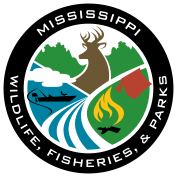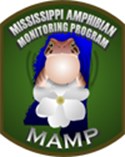
If you have questions about purchasing a license call 1-800-5GO-HUNT.
Research and monitoring efforts conducted by museum staff focus on the species of greatest conservation need outlined in the Mississippi State Wildlife Action Plan. These efforts are essential to conserving our native reptiles and amphibians and allow experts to make informed decisions to manage habitats and handle potential threats.
Current Research Efforts:
For all Gopher tortoise, Gopher frog, and Black Pine snake-related items, please contact CJ Hillard (Southern Conservation Resource Biologist)
Herpetology is the study of reptiles and amphibians. Reptiles are scaly ectothermic vertebrates, meaning their body temperature is regulated by their external environment. Amphibians are also ectothermic, but have smooth, moist skin that is permeable to gases and allows them to breathe through their skin as well as their lungs. Mississippi is home to many reptiles and amphibians which occur in a variety of habitats. Some species are completely terrestrial while others are entirely aquatic.
 The Mississippi Amphibian Monitoring Program was a volunteer-based anuran (frogs and toads) statewide monitoring for Mississippi's frog populations.
The Mississippi Amphibian Monitoring Program was a volunteer-based anuran (frogs and toads) statewide monitoring for Mississippi's frog populations.
MAMP was first established in 2001 with six surveyed routes. MAMP was canceled in 2015 due to a lack of federal funding.
At its peak, there were 76 routes statewide and 27 species recorded.
MAMP followed the protocols set by NAAMP, the North American Amphibian Monitoring Program which ended in 2015 as well.
Each route was surveyed by a verified volunteer three times a year, in the late winter, spring, and summer. The route has 10 stops located near a wetland, pond, stream, or other water feature. Each stop was monitored for five minutes and all calls heard were recorded according to a calling index. Data was then entered online.
Data gathered on MAMP routes contributes to information on the distribution of frogs and toads in Mississippi.
This data was added to that gathered around the nation to obtain a better picture of how species are doing throughout their ranges.
Several species of frogs are listed on Mississippi's Species of Greatest Conservation Need list. These species are either already listed as threatened or endangered or there is concern that they will become so.
The long-term monitoring provided by MAMP will help us better understand the health of frog populations and enable us to protect critical habitats before it's too late.
MDWFP's Mississippi Museum of Natural Science (MMNS) seeks to bring back the MAMP program for the 2023 season but with a few updates.
First, we created an app to record data in real-time.
Second, we are revamping the routes and adding acoustic recorders to routes that never had data, are difficult to access, or are hot spots we want to target for certain species of concern.
So. stay tuned to this webpage for additional updates.
Please contact Jennifer Frey (MAMP coordinator) at Jennifer.frey@mmns.ms.gov for additional information.